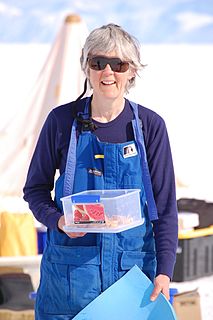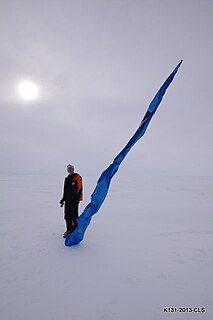Radio broadcasting began in New Zealand in 1922, and is now dominated by almost thirty radio networks and station groups. The Government has dominated broadcasting since 1925, but through privatisation and deregulation has allowed commercial talk and music stations to reach large audiences. New Zealand also has several radio stations serving Māori tribes, Pacific Island communities, ethnic minorities, evangelical Christians and special interests.

Sir Ernest Marsden was an English-New Zealand physicist. He is recognised internationally for his contributions to science while working under Ernest Rutherford, which led to the discovery of new theories on the structure of the atom. In Marsden's later work in New Zealand, he became a significant member of the scientific community, while maintaining close links to the United Kingdom.

The National Institute of Water and Atmospheric Research or NIWA, is a Crown Research Institute of New Zealand. Established in 1992, NIWA conducts research across a broad range of disciplines in the environmental sciences. It also maintains nationally and, in some cases, internationally important environmental monitoring networks, databases, and collections.

The Royal Society Te Apārangi is an independent, statutory not-for-profit body in New Zealand providing funding and policy advice in the fields of sciences and the humanities.
The following lists events that happened during 1895 in New Zealand.
The following lists events that happened during 1894 in New Zealand.
The following lists events that happened during 1848 in New Zealand.
Vida Mary Stout was a New Zealand limnographer and academic administrator. She was the first woman to be Dean of Science at a New Zealand university.
Nicola Gaston is an Associate Professor in the Department of Physics at the University of Auckland and Co-Director of the MacDiarmid Institute, New Zealand. She was previously a Senior Lecturer in Chemistry at Victoria University of Wellington and has been a Principal Investigator at the MacDiarmid Institute since 2010. Her research interests include understanding how and why the properties of clusters of atoms, such as their melting points, depend on size and electronic structure. For example, adding an extra atom of gallium to a cluster can change its melting point by 100 Kelvins.

Nancy Bertler is an Antarctic researcher, who has led major initiatives to investigate climate history using Antarctic ice cores, and best known for her leadership of the Roosevelt Island Climate Evolution Programme (RICE). She is an associate professor at the Antarctic Research Centre at Victoria University of Wellington in New Zealand.

Patricia Jean Langhorne is an Antarctic sea ice researcher. She is a Professor in the physics department at the University of Otago, New Zealand. She was previously head of department (2012–2015). She now leads the sea ice observation component of one of New Zealand’s National Science Challenges – the Deep South.
Rebecca Priestley is a New Zealand academic, science historian, and writer. She is an Associate Professor in Science in Society at Victoria University of Wellington.
The Prime Minister's Science Prizes are awarded yearly by the Prime Minister of New Zealand. They were first awarded in 2009 in order to raise the profile and prestige of science among New Zealanders. The 2016 awards were presented in early 2017.

Pamela Margaret Young was the first New Zealand woman to live and work in Antarctica. In 1969–70, she worked at Cape Bird as field assistant to her husband Euan, a biologist, and was among the first six women to fly to the South Pole. She wrote a book about her trip. The Young Peaks in Antarctica are named after her.

Margaret Ann Chapman was a limnologist, one of the first New Zealand women scientists to visit Antarctica, and the first woman to lead a scientific expedition to Antarctica. Lake Chapman, in Antarctica's Ross Dependency, was named for Chapman. Chapman spent most of her teaching career at the University of Waikato.
Agnieszka Fryckowska is a New Zealand meteorologist and Antarctic base manager who has worked with the British Antarctic Survey (BAS). Fryckowska has spent five winters in Antarctica. She is currently training to be a pilot in Northumberland. She is a recipient of the Polar Medal.
Anna Jackson is a New Zealand poet, fiction and non-fiction writer and an academic who grew up in Auckland and now lives in Wellington. Her writing has appeared in journals and anthologies, and she has published several collections of poetry. She has received a number of awards for her work, including a 1999 Louis Johnson New writers’ Bursary, the 2001 Waikato University Writer in Residence, the Katherine Mansfield Menton Fellowship in 2015, and in 2016 she was selected for the Residency Programme at the Michael King Writers’ Centre in 2017.
Laurence Fearnley is a short story writer, novelist and non-fiction writer. Several of her books have been shortlisted for or have won awards, both in New Zealand and overseas, including The Hut Builder, which won the fiction category of the 2011 NZ Post Book Awards. She has also been the recipient of a number of writing awards and residencies including the Robert Burns Fellowship, the Janet Frame Memorial Award and the Artists to Antarctica Programme. She lives in Dunedin, New Zealand.

Gabby O'Connor is an Australian Installation Artist based in Wellington, New Zealand.
Natalie Robinson, an Antarctic researcher, is based at the National Institute of Water and Atmospheric Research in New Zealand. She led the final two K131 Science Events on the sea ice of McMurdo Sound, Antarctica.







